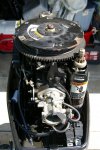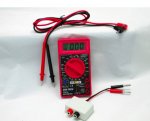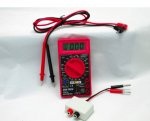What would be the cause of spark firing multiple times per revolution?
My motor is a 1995 Force 70 hp, 3 cylinder with one switchbox assembly and separate coils for each cylinder.
I first marked the cylinder # on top of the flywheel at TDC for each cylinder. When I put the timing light (TL) on cylinder #1 with engine idling and observe the flywheel, I see number 1, 2 and 3. This tells me that the #1 wire is firing 3 times per revolution, each time the individual cylinders reach TDC. I believe #1 should fire only once per revolution, and I should only see #1 on the flywheel with TL on #1 wire.
When I move TL to #2, I see 2 and 3. With TL on #3 and I see 3 and 2. It seems these two cylinders are firing two times per revolution.
I've read on this forum that this means the trigger is bad. I've also read that it may not be the trigger assembly and could be the switchbox assembly? What method can I use to isolate the problem to determine the correct fix?
Like others, I'm not interested in throwing money into parts unless I understand I have isolated the cause.
My symptoms have been rough idle and dies in gear, cutting out at the beginning of a hole shot and not reaching full RPMs (only about 4000rpm) at WOT. At wide open throttle it seems to bog down. Last summer it ran fine.
Things I have done so far: Cleaned the carb by completely disassembling. Float level looked good. Linked and sync'd the carb/timing. Set static timing to 28 degrees. Idle screw on carb is currently set to 1-1/2 turns. Verified no fuel restriction back to tank using a vacuum guage test. Fuel Pump can draw 4-5 in Hg vacuum when I pince the fuel line closed. Pump puts out 4.5 psi pressure to carb. Verified spark on all 3 cylinders. Trigger resistance is 1320 ohms on each. Stator resistance is 113 ohms Red to ground, and 3950 ohms Blue to ground. Moved coil positions with no change to multiple firing problem. #1 still fires 3 times and #2 and #3 each fire 2 times per rev.
Should I keep messing with the air/fuel mixture, or should I resolve the multiple firing per cylinder issue?
My motor is a 1995 Force 70 hp, 3 cylinder with one switchbox assembly and separate coils for each cylinder.
I first marked the cylinder # on top of the flywheel at TDC for each cylinder. When I put the timing light (TL) on cylinder #1 with engine idling and observe the flywheel, I see number 1, 2 and 3. This tells me that the #1 wire is firing 3 times per revolution, each time the individual cylinders reach TDC. I believe #1 should fire only once per revolution, and I should only see #1 on the flywheel with TL on #1 wire.
When I move TL to #2, I see 2 and 3. With TL on #3 and I see 3 and 2. It seems these two cylinders are firing two times per revolution.
I've read on this forum that this means the trigger is bad. I've also read that it may not be the trigger assembly and could be the switchbox assembly? What method can I use to isolate the problem to determine the correct fix?
Like others, I'm not interested in throwing money into parts unless I understand I have isolated the cause.
My symptoms have been rough idle and dies in gear, cutting out at the beginning of a hole shot and not reaching full RPMs (only about 4000rpm) at WOT. At wide open throttle it seems to bog down. Last summer it ran fine.
Things I have done so far: Cleaned the carb by completely disassembling. Float level looked good. Linked and sync'd the carb/timing. Set static timing to 28 degrees. Idle screw on carb is currently set to 1-1/2 turns. Verified no fuel restriction back to tank using a vacuum guage test. Fuel Pump can draw 4-5 in Hg vacuum when I pince the fuel line closed. Pump puts out 4.5 psi pressure to carb. Verified spark on all 3 cylinders. Trigger resistance is 1320 ohms on each. Stator resistance is 113 ohms Red to ground, and 3950 ohms Blue to ground. Moved coil positions with no change to multiple firing problem. #1 still fires 3 times and #2 and #3 each fire 2 times per rev.
Should I keep messing with the air/fuel mixture, or should I resolve the multiple firing per cylinder issue?























